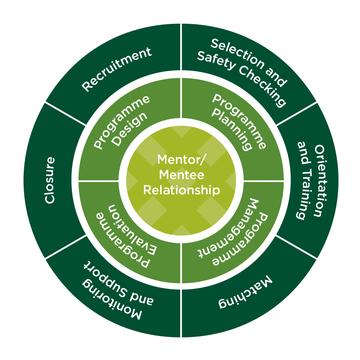Programmes
Core programme elements
Overview

International research stresses the importance for youth mentoring programmes to meet specific conditions and criteria if they are going to be sustainable and effectively encourage young people to reach their potential.
The core elements of effective pracitce are built around the life cycle of a mentoring relationship starting with recruitment and safety checking of mentors and moving through to training, matching of mentors with young people, monitoring and support of the relationships, and finally to closure or the formal completion of the mentoring relatonship.
Section 5 of the Guide to Effective Practice in Youth Mentoring covers these four stages in details. Here is a link to this: NZYMN Effective Practice Guide
The core elements of effective practice and there key activites are listed below and covered in more details in the separate web pages.
Recruitment
- Mentor recruitment plan
- Mentee recruitment plan
- Mentee referral process
- Recruitment materials
- Recruitment methods
Selection and safety checking
- Mentor selection criteria
- Mentor safety checking
- Mentee selection criteria
- Mentee screening process
Orientation and training
- Mentor orientation and training
- Mentee orientation and training
- Guidance for parents/caregivers
- Post-match training
- Programme staff training
Matching
- Matching criteria
- Matching process
- Preparation for initial match meeting
- Initial match meeting
- Match agreement
Monitoring and support
- Monitoring the relationship
- Assessing the relationship
- Supporting the relationship
- Feedback
- Acknowledgement
Closure
- Preparing mentors/mentees for closure
- Handling unplanned closures
- Rematching procedures
- Closure activities
Overview
International research stresses the importance for youth mentoring programmes to meet specific conditions and criteria if they are going to be sustainable and effectively encourage young people to reach their potential.
The core elements of effective pracitce are built around the life cycle of a mentoring relationship starting with recruitment and safety checking of mentors and moving through to training, matching of mentors with young people, monitoring and support of the relationships, and finally to closure or the formal completion of the mentoring relatonship.
Section 5 of the Guide to Effective Practice in Youth Mentoring covers these four stages in details. Here is a link to this: NZYMN Effective Practice Guide
The core elements of effective practice and there key activites are listed below and covered in more details in the separate web pages.
Recruitment
- Mentor recruitment plan
- Mentee recruitment plan
- Mentee referral process
- Recruitment materials
- Recruitment methods
Selection and safety checking
- Mentor selection criteria
- Mentor safety checking
- Mentee selection criteria
- Mentee screening process
Orientation and training
- Mentor orientation and training
- Mentee orientation and training
- Guidance for parents/caregivers
- Post-match training
- Programme staff training
Matching
- Matching criteria
- Matching process
- Preparation for initial match meeting
- Initial match meeting
- Match agreement
Monitoring and support
- Monitoring the relationship
- Assessing the relationship
- Supporting the relationship
- Feedback
- Acknowledgement
Closure
- Preparing mentors/mentees for closure
- Handling unplanned closures
- Rematching procedures
- Closure activities

